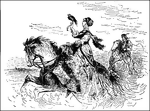
Falconry as Practiced by a Noblewoman of the Middle Ages on Horseback
A high-born, noblewoman rides a stallion while holding a falcon perched on her right hand. She is wearing…

Peasants Using Mallets to Break Clods of Earth Before Farming the Land
Two medieval peasants, a man and woman, break clods of earth apart with mallets. The man is swinging…

Reaping Grain the 14th Century
Men and women reap the grain from a field in the 14th century. Two women are bent over using sickles…

A German Town on the Main River, Possibly Würzburg
Illustration of a town in Germany during the late Middle Ages, or medieval period. The town sits on…

A Medieval Shop, Storefront
Illustration of the storefront of a medieval shop on a street with buildings on either side. Spires…
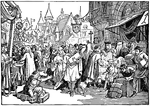
A Street Fair in 13th Century France
Illustration of a bustling street fair in France during the 13th century. Numerous people crowd the…

A Southern View of the Cathedral of Cologne in Germany
Illustration of the southern side of the Cathedral of Cologne. Construction on the cathedral was begun…

Sceat, an Early Anglo Saxon Coin
"Specimens occur in gold, but most frequently in silver. Their average weight is 15 grains, and they…
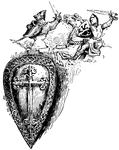
Medieval Shields from the 13th and 14th Centuries
Illustration including one large shield from the first half of the 13th century, bearing a decorative…

A Woman in a Dress - 12th Century, with Long and Hanging Sleeves
"At different times during the middle ages extraordinarily long, pendant sleeves were in use, sometimes…
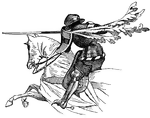
A Knight on Horseback, Wearing a Woman's Sleeve as a Favor
Illustration of a knight, riding a horse at full gallop, carrying a javelin and wearing full armor.…
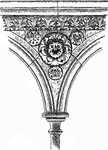
Sculptured Spandrel from Mont Saint-Michel
"...the triangular space comprehended between the outer curve or extrados of an arch, a horizontal line…
Spire from the Senlis Cathedral
Illustration of a spire of the Senlis Cathedral in France, early 13th century. It is "one of the earliest…

Kiss under the Mistletoe
A man holds mistletoe over a woman he is kissing. Both are dressed in medieval attire.